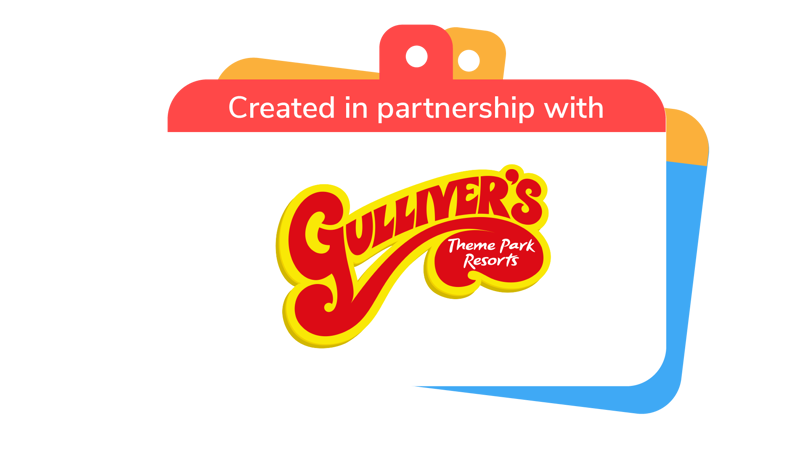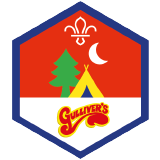
Running a campfire event
You’ll need
- Kindling (for example, small sticks)
- Firewood
- Buckets
- Access to water
- Matches
- First aid kit for burns
Try this at Gulliver's Theme Park Resorts!
Thinking of running this activity? Well, why not try it during a trip to Gulliver's Theme Park Resorts with your group. Whether you are there for a Scouts Takeover weekend, or heading out on a group visit with just your troop, this activity can be a great addition to your trip programming.
Learn more about the partnership hereBefore you begin
- Use the safety checklist to help you plan and risk assess your activity. Additional help to carry out your risk assessment, including examples can be found here. Don’t forget to make sure all young people and adults involved in the activity know how to take part safely.
- Make sure you’ll have enough adult helpers. You may need some parents and carers to help if you’re short on helpers.
Staying safe around your campfire
- Make sure everybody knows how to be safe around a campfire.
- You could run our fire safety activities, such as Sitting safely by a campfire, prior to building the campfire.
Preparing to host the campfire
- Find out who'll be at your campfire. You may want to plan some entertainment, such as singing campfire songs or telling stories.
- If you'll need entertainment, find how long the entertainment needs to last. It may be best to plan some extra songs, just in case time passes quickly.
- Decide who'll make your campfire and when they’ll make it. Do you want it to be burning before you start singing, or do you want to sing as the fire is lit and the first piece of wood is added?
- The beginning of a campfire should have songs that draw people’s attention or songs that people might recognise, so everyone's encouraged to join in. Choose two or three easy-to-learn or well-known songs to begin your campfire.
- The middle of a campfire should have songs to get everyone energised. Choose songs that are lively and funny, so everyone can join in. Songs with repetition and actions are perfect!
- The end of a campfire should let people wind down from all of the fun and excitement. Choose calmer songs – are there any that help people to relax or wind down before sleeping?
- Think about how you’ll lead the songs – do different people want to lead different songs? Will you print any words, or teach people as you sing?
- Once you’ve planned your songs (and perhaps some refreshments), you’re all set to host your campfire.
- If you're having refreshments, remember to check your ingredients against any allergy or dietary requirements to ensure everyone can enjoy the recipe. This may mean using alternative ingredients.
Planning and gathering wood for your campfire
- Before starting, fill a large bottle or bucket with water. Keep it within reach at all times, in case of an emergency.
- A responsible adult should check the area. It must be somewhere you know you’re allowed to light a fire. It should also be flat and clear from anything that’ll burn – and you should think about where the smoke will blow, too.
- Collect lots of dry wood or a variety of sizes – everyone should gather more than you think you’ll need.
- Now, split your wood into four piles:
- The first pile should contain pieces of wood about as thick as a matchstick.
- The second pile should contain wood that’s a bit thicker – two or three matchsticks thick.
- The third pile should contain twigs and sticks that are even thicker – about the size of a thumb.
- The fourth pile is for any wood bigger than this.
Build your campfire
- Start with a dry base. A good way to create this is by putting down bark.
- Put a large stick onto the dry base. Take the first pile of kindling (the wood pile with the smallest pieces), and lean the whole bunch on the large stick. You need to leave space underneath the kindling for your tinder to sit, without being squashed.
- Take your tinder. If you’re using cotton wool, tease it out so it takes up more space and has plenty of air mixed in.
- Put the tinder in the space underneath the kindling, but slightly to one side. This is so that you can easily get your hands out of the way once it’s alight.
- Use your matches (or flint and steel) to light the tinder. Make sure you move your hands out of the way quickly. The tinder will burn and set the kindling on fire. Watch until the flames come through the top of the bundle of kindling.
- Once the flames have come through your first bundle of wood, lay the second pile on top at a slight angle. Wait for the flames to burn through the top.
- When the flames have come through the second pile, add your third bundle of thumb-width sticks on top at a slight angle.
- Again, when the flames have come through this third pile of wood, you can be confident that your fire is burning well.
- Keep adding bigger and bigger pieces of fuel as needed, making sure not to squash or suffocate the flames.
Enjoy your campfire
- Remind everybody how to stay safe around a campfire.
- Everyone should join in with the entertainment in whichever way they feel comfortable – people may want to sing campfire songs. If you sing songs, people can sing along, join in with the actions, do both or do neither.
- If you're having refreshments, remember to check your ingredients against any allergy or dietary requirements to make sure everyone can enjoy the recipe. This may mean using alternative ingredients.
Finish your campfire
- Make sure the fire is completely extinguished before leaving it. The coals can still be hot even after the flames have stopped.
- A responsible adult should pour plenty of water over the coals, and stir round some earth with the ashes.
Reflection
This activity helped you to build friendships. Did you feel closer to people in your community when you shared the campfire with them? Did you make any new friends? Did you strengthen friendships by sharing memories?
This activity also helped you to be responsible. Were you trustworthy around the fire? What does it mean to be responsible and trustworthy around fire? Did you help others to stay safe and be responsible?
Safety
All activities must be safely managed. You must complete a thorough risk assessment and take appropriate steps to reduce risk. Use the safety checklist to help you plan and risk assess your activity. Always get approval for the activity, and have suitable supervision and an InTouch process.
- Food
Remember to check for allergies, eating problems, fasting or dietary requirements and adjust the recipe as needed. Make sure you’ve suitable areas for storing and preparing food and avoid cross contamination of different foods. Take a look at our guidance on food safety and hygiene.
- Fires and stoves
Make sure anyone using fires and stoves is doing so safely. Check that the equipment and area are suitable and have plenty of ventilation. Follow the gas safety guidance. Have a safe way to extinguish the fire in an emergency.
- Cooking
Teach young people how to use cooking equipment safely. Supervise them appropriately throughout. Make sure it’s safe to use and follow manufacturers’ guidelines for use.
- Outdoor activities
You must have permission to use the location. Always check the weather forecast, and inform parents and carers of any change in venue.
- Flammable items
Always take care when using flammable items, especially if you’re near fire. Always follow the manufacturer’s instructions and guidelines.
- Hot items and hot water
Kettles, cookers and microwave ovens produce a lot of heat by the very nature of them. Caution is needed when in contact with items that have been heated and young people should use them under adult supervision. Use on a suitable surface, protecting it if necessary. Never leave hot items unattended and make sure there’s a nearby first aid kit, with items to treat burns/scalds.
Adapt the songs to your audience. Some songs may have lots of moving around or need people to hold hands or link arms, so you may want to change the actions so everyone can be included.
If you have refreshments, remember to check your ingredients against any allergy or dietary requirements to ensure everyone can enjoy the recipe. This may mean using alternative ingredients.
All Scout activities should be inclusive and accessible.


